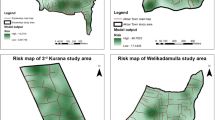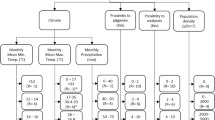Abstract
Encephalitis is a complex disease with a high mortality, morbidity and disability ratio. It is basically a paediatric problem. Every year, from July to November, the outbreak of encephalitis causes many deaths and long-term disabilities among children and young adults. Geographical and seasonal distribution of encephalitis shows that the disease has a positive correlation with the environmental variables, such as rainfall, humidity, temperature and waterlogging) as well as with socio-economic variables like population below the poverty line, population up to 15 years of age, malnutrition, pig/cattle living near/inside the house and housing conditions, which may have a significant impact on the timing, incidence and magnitude of the disease outbreak and vulnerability of the population. Identification of encephalitis high-risk areas is an important and effective tool for policy makers to provide more effective preventive methods, health services, vaccination programmes, vector control, and other public health initiatives. Uttar Pradesh is a highly encephalitis affected state among all the states of India and its eastern part is a highly encephalitis-sensitive area. The study tries to create an Encephalitis Risk Model for the identification of potential areas of encephalitis in a subtropical region, located in the eastern part of Uttar Pradesh, state (Gorakhpur tehsil) of India. Factors selected to create risk model for encephalitis are inhabited/uninhabited (abandoned) villages, land use, pig population distribution, occurrence of encephalitis cases and population under age of 6. Every variable has been given due weightage and relative importance according to their impact on the occurrence and incidence rate of encephalitis. Encephalitis Risk Model for Gorakhpur tehsil classifies the area into five categories of risk zones. About 62.08% of the area of the tehsil is under low/no risk category and only 14.75% area constitutes the high-risk area. The rest of the 23.17% area is in the moderate-risk category. The result indicates that the disease risk areas are almost homogenously spread over the region with several small patches reaching the extreme value of risk and making them highly sensitive. The model is validated by using 45 sites of sample villages and wards. The multiple linear regression is calculated to know the correlation between the selected variables and their influence values and Pearson’s and Spearman’s correlations of coefficient are used for establishing correlation between identified encephalitis risk areas and actual reported disease incidence using sample sites to validate the model.







Similar content being viewed by others
References
Ahirrao K. D. (2014). Epidemiology of acute encephalitis syndrome/Japanese encephalitis: a mosquito-borne disease in Gorakhpur district, SJIF, Sept-October, Vol.-II/XIV
El-Zeiny Ahmed, El-Hefn Asmaa , Sowilem Mohamed ( 2017). Geospatial techniques for environmental modeling of mosquito breeding habitats at Suez Canal Zone, Egypt, The Egyptian Journal of Remote Sensing and Space Science, Volume 20, Issue 2, December:283–293
Alto B.W. and Juliano S.A. (2001). Temperature effects on the dynamics of Aedesalbopictus (Diptera: Culicidae), Populations in the Laboratory, J Med Entomol, 38: 548–556
Arifin S. M. Niaz, Arifin Rumana Reaz, Pitts Dilkushi de Alwis, Madey Gregory R. (2013). Integrating an agent-based model of malaria mosquitoes with a geographic information system, Proceedings of the European modelling and simulation symposium 2013 Eds. Bruzzone, Jimenez. Longo, Merkuryev, 978 8897 999 225
Brewster Carlyle C. (2012). Geospatial modeling for vector detection and surveillance, presented in Virginia Tech, Virginia Polytechnic Institute and State University, September 18
Chakrabarty S, Saxena VK, Bhardwaj M (1986) Epidemiological investigation of Japanese encephalitis outbreak in Gorakhpur and Deoria districts of Uttar Pradesh, 1985. J Com Dis 18(2):103–108
Duncanson G (1996) Mapping childhood diseases with a geographic information system. Pharm J 257:679–670
Emch M (1999) Diarrheal disease risk in Matlab, Bangladesh. Soc Sci Med 49(4):519–530
Fleming G, Merwe M, McFerren G (2007) Fuzzy expert systems and GIS for cholera health risk prediction in southern Africa. Environmental Modeling and Software 22(4):442–448
Fuentes MA, Kuperman MN (1999) Cellular automata and epidemiological models with spatial dependence. Physica A 267:471–486
Gupta N, Hossain S, Lal R, Das BP, Venkatesh S, Chatterjee K (2005) Epidemiological profile of Japanese encephalitis outbreak in Gorakhpur, UP in 2004. J Commun Dis 37:145–149
Handique B.K., Khan S.A., Chakraborty K., Goswami J., Sarma K.K. (2011). Spatial statistical analysis of Japanese encephalitis occurrence and identification of disease hot spots – case studies in a JE endemic district of north east India, International Journal of Geoinformatics, Vol. 7, No. 1, March: 7–14
Hönig Václav et al. (2011). Tick-borne diseases risk model for south Bohemia (Czech Republic), GIS Ostrava, 23. - 26. 1
Jacob Benjamin G., Nathan D., Burkett Cadena, Jeffrey C Luvall, Sarah H. Parcak, Christopher J. W. McClure, Laura K. Estep, Geoffrey E. Hill, Eddie W. Cupp, Robert J Novak and Thomas R. Unnasch (2010). Developing GIS-based eastern equine encephalitis vector-host models in Tuskegee, Alabama, International Journal of Health Geographics, 09:12, http://www.ij-healthgeographics.com/content/9/1/12
Kakkar M., Rogawski E.T., Abbas S. S., Chaturved S., Dhole T. N., Hossain S. S., Krishnan S. K. (2013). Acute encephalitis syndrome surveillance, Kushinagar district, Uttar Pradesh, India, 2011–2012, Emerging Infectious Diseases, Vol. 19, No. 9, September
Kanojia PC, Shetty PS, Geevarghese G (2003) A long-term study on vector abundance and seasonal prevalence in relation to the occurrence of Japanese encephalitis in Gorakhpur district, Uttar Pradesh. Indian J Med Res 117(March):104–110
Lars E, Rebecca EJ (2011) Using Geographical Information System and Decision Support Systems for the Prediction, Prevention and Control of Vector-Borne Diseases. Annu Rev Entomol 56:41–61.
Lindsay SW, Martens WJ (1998) Malaria in the African highlands: past, present and Future. Bull World Health Organ 76(1):33–45
Martin PH, Lefebvre MG (1995) Malaria and climate: sensitivity of malaria potential transmission to climate. Ambio 24(4):200–207
McCullagh P, Nelder J (1989) Generalized linear models. CRC Press, Boca Raton
Myers MF, Rogers DJ, Cox J, Flahault A, Hay SI (2000) Forecasting disease risk for increased epidemic preparedness in public health. Adv Parasitol 47:309–330
Napier M., Fleming G. (2003). Applications of GIS and modeling of dengue risk areas in Hawaiian island, in proceedings of 30th Symposium for Remote Sensing of Environment: Information for Risk Management and Sustainable Development, International Symposium on Remote Sensing of Environment, Tucon, AZ: 260-263
Osei F. and Duker A. (2008). Spatial dependency of V. Cholera prevalence on open space refuse dumps in Kumasi, Ghana: a spatial statistical modeling, International Journal of Health Geographics, 7(1):62
Osei FB, Duker AA, Augustijn EW, Stein A (2010) Spatial dependency of cholera prevalence on potential cholera reservoirs in an urban area, Kumasi, Ghana. Int J Appl Earth Obs Geoinf 12(5):331–339
Palaniyandi M, Anand PH, Maniyosai R (2014) Spatial cognition: a geospatial analysis of vector borne disease transmission and the environment, using remote sensing and GIS. International Journal of Mosquito Research 1(3):39–54
Rathi AK, Kushwaha KP, Singh YD, Singh J, Sirohi R, Singh RK (1993) JE virus encephalitis: 1988- epidemic at Gorakhpur. Indian Paediatric 30:325–333
Robinson TP (2000) Spatial statistics and geographical information systems in epidemiology and public health. Adv Parasitol 47:81–128
Rogers DJ, Randolph SE (2000) The global spread of malaria in a future, warmer world. Science 289(5485):1763–1766
Selvaraju G, Balasubramaniam A, Rajendran D, Kannan D, Geetha M (2013) Multiple linear regression model for forecasting Bluetongue disease outbreak in sheep of north-west agro-climatic zone of Tamil Nadu, India. Vet. World 6(6):321–324. https://doi.org/10.5455/vetworl,.321-324
Shivalingappa BJ, Pandit PV (2012) Multiple logistic regression model to predict risk factors of oral health. Romanian Statistical Review nr. 5.
Verma S., Gupta R.D. (2014). Spatial and temporal variation of Japanese encephalitis disease and detection of disease hotspots: a case study of Gorakhpur district, Uttar Pradesh, India, ISPRS Annals of the Photogrammetry, Remote Sensing and Spatial Information Sciences, Volume II-8
White HS, del Rey AM, Rodríguez SG (2007) Modeling epidemics using cellular automata. Applied Mathematics and Computation 186:193–202
Funding
The study was carried out as a part of the major research project, funded by Natural Resources Data Management System (NRDMS), division of Department of Science and Technology (DST), New Delhi. The project received financial assistance from the NRDMS division.
Author information
Authors and Affiliations
Corresponding author
Rights and permissions
About this article
Cite this article
Tyagi, N., Sahoo, S. Geospatial disease risk modeling for the identification of potential areas of encephalitis in a subtropical region of India: a micro-level case study of Gorakhpur tehsil. Appl Geomat 12, 209–223 (2020). https://doi.org/10.1007/s12518-019-00287-2
Received:
Accepted:
Published:
Issue Date:
DOI: https://doi.org/10.1007/s12518-019-00287-2




